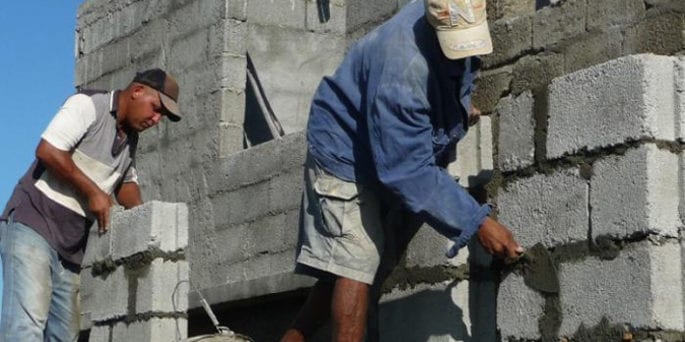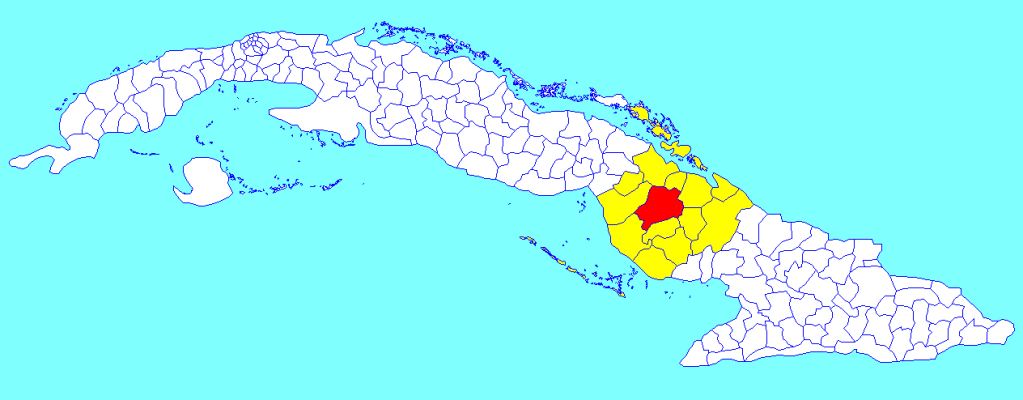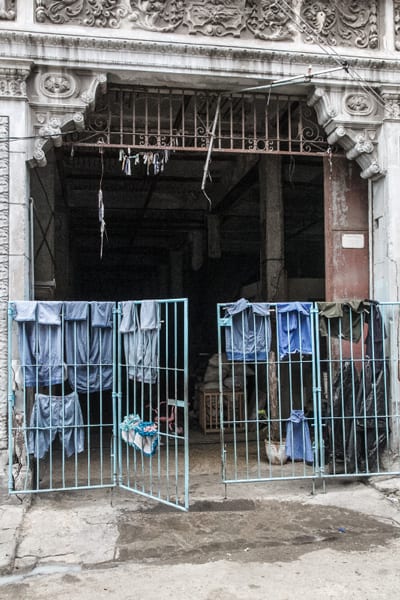Building a Home in Cuba
by Daniel Valero (Progreso Semanal)

HAVANA TIMES — Until January 2015, the majority of Cubans who wanted to buy a piece of land and build their home only had one option: to buy it from an individual for a nearly always prohibitive price. However, even this alternative was a small window of opportunity which only a very select few could take advantage of.
Luis Miguel Rodriguez knows because he experienced this firsthand. He’s been trying to buy a piece of land where he can build his home pretty much since his wedding day and for more than five years he wasn’t successful. “Back then – around 2005 – you couldn’t sell houses and I didn’t want to take the risk with some side deal. Also, I didn’t have that much money; I only had enough to pack up and move.”
His story is that of countless visits to plot owners, redtape at municipal Housing and Physical Planning office, letters to the Government… all of this in vain. “At that time, I came across some 5 x 20 m plots which used to cost up to 40,000 pesos (2,000 USD), and I’m not talking about Camaguey city center, but suburbian neighborhoods such as Montecarlo or Jayama. In the end, I was lucky that they changed the law and I could finally buy a small semi-built house in El Retiro. I’ve slowly been finishing it off.”
When the Cuban government announced that property could be bought and sold in November 2011, many people found themselves face to face with an opportunity to make some money or to finally get their own home. Others took advantage of this new law to change their old colonial buildings for small houses, closer to their needs or financial means. However, in a country where the large part of its housing is in a regular or poor state, and there is a deficit of hundreds of thousands of homes, this measure was just part of the solution.
Lack of investment

With just over 300,000 inhabitants and substantially damaged housing, Camaguey is the same city that hosted the last 26th July celebration of the “happy 80s” in 1989. It is at least the same with regard to its basic infrastructure and master plans for developing the city. This is what an official at the Provincial Physical Planning office believes, who has had to update investment programs which “will be implemented at some point, but I can almost certainly say that I won’t live to see it.”
Today, less than half of the population in the capital of Camaguey has access to sewage systems, a quarter of them don’t have a water line and some neighborhoods don’t have either, whatsoever, both of which are so implicit to modern life. There is a similar situation with electricity distribution networks, albeit not to such a great extent.
Although it’s been two years since the aqueduct has been under development using capital from an investment, which according to Luis Palacios Hidalgo, the Investment director of this institution, has all of the “necessary equipment and devices,” there still isn’t a regular and stable supply of water and quality of this water.
Therefore, opening new services is not high priority. “Due to the many problems this network presents, our priorities lie in renovating the system and expanding to more specific areas. You can’t think about expanding services if you haven’t first got a stable supply running along already existing pipes,” pointed out Richard Oliva, an assistant manager from the Operations department.
If this is the reality of this aqueduct, which has benefitted from a 40 million USD “soft” loan given by Saudi Arabi in 2014, it’s not hard to imagine the obstacles that are blocking the way for other systems such as sewage and roads, which haven’t received millions of dollars. The probem is that without them, new areas can’t be added to the current urbanization process. And without urbanization, new plots of land can’t be handed out.
The long way home
On January 5th 2015, under the protection of Decree-Law 322, the Physical Planning Institute (IPF) took on the majority of what was formerly dealt with by its equivalent, the Housing office. This change represents an important step in getting rid of bureaucratic obstacles, especially in the authorization of selling State-owned plots to individuals, an option which hasn’t existed up until now.

For Cuba, this was a revolutionary decision, as it has opened up a new channel for those who are adamant that they want to build their home by themselves. Furthermore, it allows local governments to take advantage of areas which they hadn’t found a real use for.
In theory, everyone wins; but Odalys Martinez thinks differently.
Her standpoint is supported by more than a year of unsuccessful redtape to get a place where she could build a house and live independently. During this time, she has seen everything. “I knew that this was going to be a great war ever since it began, but I had faith that it would be resolved somehow, or that it would be a little more on target at this stage, but that’s not been the case. I remember that there were even some plots of land near my house, where there used to be a carpark before, and some of us asked for this land. It was useless, as people turned up overnight who had greater “priority” and they got it. Do you know what their “priority” was? Well, one of the people who was given permission to build was the daughter of a government leader, the other person had the right friends and so on. The whole housing scene is rife with huge amounts of corruption, and nobody will be able to fix this, ever.”
As a rule, municipal Physical Planning offices have up to 60 working days to respond to people’s requests. Among these people, priority is given to those “affected by natural disaster, those in need of getting out from dangerous conditions, the very low income cases and people living in shelters, etc.” However, there aren’t reliable deadlines for people waiting to get a response and files have been lost on more than one occasion or have been filed away without even giving a reason to those who made the request.
“The truth is, we have suffered delays in processing files. This situation is due to problems in organization and to the lack of inspectors and other staff here at the office, but we have never not dealt with a request,” a manager at the Physical Planning office in Camaguey explains. In her opinion, there is a great lack of awareness among the population, “who don’t always understand the complexity of the task at hand.”
Outside of the institution, the majority of applicants we consulted said that their problem hadn’t been resolved, nor had they received a definite answer after months of paperwork.
Apart from opinions, the only undeniable fact is that, during the first year of Decree-Law 322 being implemented, there wasn’t an increase in the number of houses completed in Camaguey. In fact, the opposite happened. According to the Office for National Statistics and Information, out of the 2795 new homes built in the entire province during 2010 (1707 of them were privately built), in 2015, that figure had decreased to only 1006 (540 by individuals).
This same dynamic is becoming widespread across the whole country and it kicked off a heated debate at the Industry, Building and Energy Committee at the National Assembly last July. There, it was revealed that during 2015, 53,942 plots had been requested and only 6,427 had been designated. The first few months of 2016 didn’t reveal a more encouraging landscape, admitted Diana Rosa Suarez Matias, the Head of IPF’s Legal Department. Until the end of May, 12,485 requests had been filed, and in spite of there being a great availability of plots (almost 15,000) paperwork for only 2,949 of them had been completed.
“If somebody asked me for advice, what would I tell them?” speculates Luis Miguel rhetorically “well it’s very simple: whoever has the means, should try and save their money and then buy the house already made. It’s always easier here to improve something that was there before than embark on a long struggle like this one. Also, there aren’t any good plots of land left in Camaguey.”
Unfortunately, the same “philosophy” which could well be applied to the rest of Cuba, doesn’t inherently hold the correct answer. The island needs new housing, but the problem begins with where to build them.






So true, Fascism that prevails in Cuba needs to end.
Fascism comes from the Latin fascio, meaning “bundle, or political group.” In fascism, the people are looked at as a bundle — one body that must be controlled by the government with absolute force. There’s no option to vote, no chance to impeach a leader, and no freedom to stand up against the governing elite.
I have family in a small town called Florida just west of Camaguey. It’s even worse there.
Real Estate equity, equity leads to profit, profit leads to more taxes and that is what Cuba needs!!
This article didn’t even mention the difficulties of finding the lumber, plumbing, wiring, etc. needed to build new homes or to improve current homes. It’s not like people have a Home Depot or Lowe’s to go to.
Visited Camaguey about 6 years ago. Didn’t realize that the situation was that bad.
It would not be socialism if the government “got out of the way”.
It comes down to the need for investment capital. An inherit flaw in socialism is the lack of productivity incentives and ability to save investment capital. The government needs to set rules and then get out of way in order to unleash economic forces that will increase housing stock.